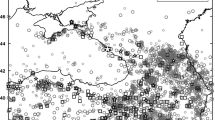Abstract
Up to now, the search for increased reliability in probabilistic seismic hazard analysis (PSHA) has concentrated on ways of assessing expert opinion and subjective judgement. Although in some areas of PSHA subjective opinion is unavoidable, there is a danger that assessment procedures and review methods contribute further subjective judgements on top of those already elicited. It is helpful to find techniques for objectively assessing seismic source models that show what the interpretations physically mean in terms of seismicity. Experience shows that well-meaning but flawed design decisions can lead to source models that are incompatible with the seismic history that was used as input. In this paper a method is demonstrated in which large numbers of synthetic earthquake catalogues, that match the completeness thresholds of the historical catalogue, are generated. The study area can be divided into a grid of uniform cells, and the number of earthquakes in each cell in both the historical catalogue and each simulated catalogue are then counted. Comparison of the historical pattern and a set of 1,000 simulated patterns, using a X2 test, shows if the historical pattern is credibly a member of the set of outcomes obtainable from the seismic source model. A second method is to chart the distribution of a large sample of simulated catalogues in terms of magnitude frequency, and observe whether the historical catalogue is comfortably within this distribution, or an outlier. If it proves impossible to replicate the historical catalogue using the model, it casts doubt on whether the model is a valid depiction of the seismicity rates that will govern the future hazard. At the very least, the disparity needs careful investigation to ensure the model is error-free. A worked example is presented here for the UK, using a source model that was used in Global Seismic Hazard Map (GSHAP), compared to one that was artificially constructed to be credible but flawed. Two tests find the GSHAP model to be an acceptable representation of the pattern of seismicity in the UK, while the artificial model is conclusively rejected.
Similar content being viewed by others
References
Bernreuter DL, Savy JB, Mensing RW, Chen JC (1989) Seismic hazard characterisation of 69 nuclear power plant sites east of the rocky mountains. US Nuclear Regulatory Commission, NUREG/CR-5250
Budnitz RJ, Apostolakis G, Boore DM, Cluft LS, Coppersmith KJ, Cornell CA, Morris PA (1997) Recommendations for probabilistic seismic hazard analysis: guidance on uncertainty and use of experts. US Nuclear Regulatory Commission, NUREG/CR-6372
Grünthal G, Bosse C, Musson RMW, Gariel J-C, Crook TD, Verbeiren R, Camelbeeck T, Mayer-Rosa D, Lenhardt W (1996) Joint seismic hazard assessment for the central and western part of GSHAP region 3 (Central and Northwest Europe). In: Thorkelsson B (ed) Seismology in Europe. Icelandic Met. Office, Reykjavik, pp 339–342
Jiménez MJ, Giardini D, Grünthal GThe Sesame Working Group (2001) Unified seismic hazard modeling throughout the Mediterranean region. Bolletino di Geofisica Teorica ed Applicata 42:3–18
Krinitzsky EL (1993) Earthquake probability in engineering - Part 1: the use and misuse of expert opinion. Eng Geol 33: 257–288
Mucciarelli M, Peruzza L, Caroli P (2000) Tuning of seismic hazard estimates by means of observed site intensities. J Earthq Eng 4: 141–159
Musson RMW (1994) A catalogue of British earthquakes. British geological survey global seismology report, WL/94/04
Musson RMW (2000) The use of Monte Carlo simulations for seismic hazard assessment in the UK. Annali di Geofisica 43: 1–9
Musson RMW (2004) Objective validation of seismic hazard source models. Proceedings of the 13th world conference on earthquake engineering, Vancouver 2492
Musson RMW, Winter PW (1996) Seismic hazard of the UK Report AEA/CS/16422000/ZJ745/005
Pharaoh TC (1996) Tectonic map of Britain, Ireland and adjacent areas, 1:1 500 000. British Geological Survey, Keyworth
Slejko D, Peruzza L, Rebez A (1998) Seismic hazard maps of Italy. Annali di Geofisica 41: 183–214
Stucchi M, Albini P (2000) Quanti terremoti distruttivi abbiamo perso nell’ultimo millenio? Spunti per la definizione di un approccio storico alla valutazione della completezza. In: Galadini F, Meletti C, Rebez A (eds) Richerche del GNDT nel campo della pericolosita sismica (1996–1999). CNR-GNDT, Rome, pp 333–343
Woo G (1996) Kernel estimation methods for seismic hazard area source modelling. Bull Seismol Soc Am 86: 353–362
Yarnold JK (1970) The minimum expectation in X2 goodness of fit tests and the accuracy of approximations for the null distribution. J Am Stat Assoc 65: 864–886
Author information
Authors and Affiliations
Corresponding author
Rights and permissions
About this article
Cite this article
Musson, R.M.W., Winter, P.W. Objective assessment of source models for seismic hazard studies: with a worked example from UK data. Bull Earthquake Eng 10, 367–378 (2012). https://doi.org/10.1007/s10518-011-9299-6
Received:
Accepted:
Published:
Issue Date:
DOI: https://doi.org/10.1007/s10518-011-9299-6




